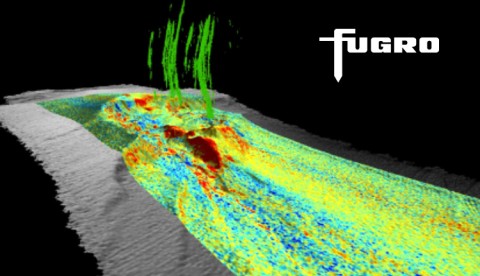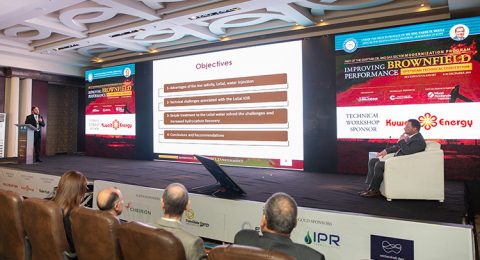Industry experts have been developing and implementing new techniques in order to boost oil and gas productivity. These innovative applications and new technologies that are designed to meet a growing demand for energy are of particular value to Egypt’s expanding oil and gas sector.
The third technical workshop of the Upstream Technical Convention was dedicated to the “Application of New Technology.” It included three presentations by International Oil Companies (IOCs) and national oil companies (NOCs) representatives alike, who focused on new ideas, newly implemented technologies, and relevant success stories.
Seismic Stimulation
The first presentation was by Bill Wooden, Vice President of the Applied Seismic Research (ASR) Corporation. Wooden presented his and business partner Sergey Kostrov’s trademarked “Seismic Stimulation” Tool, along with relevant case studies that prove its simple, yet effective approach to increase oil production through revitalizing mature fields.
Wooden focused on the importance of Enhanced Oil Recovery (EOR) techniques as an effective way to boost oil production and clarified that, “The way [ASR] enhance[s] oil recovery does not follow the traditional flow path.” As Wooden explained, Seismic Stimulation’s approach has thusly proven increases in oil production of greater than 20% in numerous fields. Discussing Seismic Stimulation across boundaries, he also explained that its application contributed to a production increase of 30% in the seven wells drilled in Belayim accounts, or approximately 1,200 billion barrels per day (b/d).
Regarding shale recovery technologies and tools, Wooden elaborated on how a single ASR Tool was one of the most productive methods. “I do not know how many shale reservoirs there are in Egypt but this is a very good technology for that – and believe it or not, our tool is very simple,” he highlighted. Wooden concluded his presentation by showing how ASR uses Dynocard to track and monitor the performance of the Seismic Stimulation Tools.
During his breakout session, Wooden received numerous questions from the audience concerning EOR and ASR, one of which enquired about the limitation of applying the presented techniques. Wooden’s answer explained how only high gas oil ratio (GOR) wells above [2,000] are unsuitable but that the depth limitation has no effect at all.
Enhanced Characterization of Productive Intervals
The second presentation focused on a paper entitled, “Zohr Field: Enhanced Characterization of Productive Intervals by Means of an Innovative Temperature Monitoring Application During Well Testing,” that was introduced by co-author and Zohr Task Force Petrobel Reservoir Expert Iskander Abdeddaiem. He explained how understanding fluid movement from the reservoir through the perforated intervals is crucial for well management and that it is strategic during well test operation. This knowledge is also required for reservoir characterization as it provides reliable input for pressure test analysis.
“Historically, reservoir information is collected after the well test operation with PLT acquisition, leading to cost increase and risks increase, especially in deep water wells,” Abdeddaiem said. The main temperature concepts include, “…temperature surveys, which are the backbone of logging for downhole fluid movement detection,” he added. Usually the temperatures in wells increase with depth and the actual rate of increase will depend upon the geographic area, formation mineralogy, rocks petro-physical properties and rocks’ thermal features.
Representing a new technique, Abdeddaiem explained that the “Multiple Discrete Temperature Sensor System” is a wireless temperature monitoring system that allows continuous high-resolution temperature profiles to be gathered from any section of the well.
Regarding Zohr’s well-test description, “Two well tests have been successfully performed in wells Zohr-2 (North-east Culmination) and Zohr-5 (South Western culmination),” said Abdeddaiem, noting that the results show that both wells are characterized by a great production capacity. Deliverability is estimated up to 250 million standard cubic feet per day (mscf/d), per well in the final production configuration.
Abdeddaiem concluded that the multiple discrete temperature sensors deployed with TCP guns has been successfully applied during well test operation in Zohr-5. No sensor damage was noted during the perforating operation. In addition, a reliable understanding of the reservoir behavior and well deliverability has been achieved safely, thus providing a downhole flow allocation during well test time.
Finally, Abdeddaiem explained how integration of the concurrent data from a single well test and a MDTS tool permits savings in the range of 15% when compared to a single well test with PLT, or 40% if compared to a dual well test strategy.
In the open discussion that followed his presentation, Abdeddaiem received a question concerning the role of temperature profiles in improving well analysis. He supported their application and explained that, “Understanding the temperature profile is a key point to understanding the contribution of each part of your reservoir. Since the technology is already available, you should take advantage of it and use it.”
Powered Dump Flood
The third session was dedicated to “Enhanced Oil Production Using Powered Dump Flood,” as presented by BHGE’s Artificial Lift Regional Sales Manager, Walid Abdelrahman, who focused on how Powered Dump Flood adds value, through its minimal environmental impact, higher production, enhanced reliability and economic gains. Conventional water flood was ruled out on account of limited productivity and negative agricultural impact. “Installing a Dump Flood ESP with in a dual injection completion has saved [an unspecified] client over $70,000 per month,” Abdelrahman said. Moreover, he explained that reservoir characteristics change from time to time. He stressed the importance of knowing the root cause of the failure – and to design the pump to fit its purpose.
In addition to powered injection, the six Powered Dump Flood systems running so far have demonstrated their capability to increase oil recovery. “The cost savings are plus or minus $ 2 million per year, per field,” he noted.
Following his presentation, Abdelrahman received a question during the breakout session querying how Powered Dump Flood could help Egypt meet the targets of its Modernization Program. “Boost the production, enhance the well life, and minimize the cost per barrel – those are the aspects we are looking for,” he explained. “At the end of the day, the discussions we had will bring us insights on two things: The possibility of the cost per barrel being down, which will encourage new investments, and the life-increase of the equipment.” Abdelrahman projected that, “…if [the companies] put those actions into a timeline, I believe by the middle of the year, or the third quarter, we would be able to make a change.”
Recovering oil and increasing production is becoming more difficult at a time when oil fields are declining. Effective techniques used to extract more oil from mature fields are hence crucial. Commenting on the three presentations, multiple attendees mentioned that cost-effective reservoir monitoring is essential to make well-informed field-development decisions, mitigate project risks and meet production targets.
“[These were] very interesting and strong presentations. All three were novel applications [representing] new concepts brought together with valued cases to rise. I think there is a lot of interest from the attendees and a lot of feedback to be received. Excellent session,” Ismail El Kholy, Strategic Projects Director at Schlumberger and one of EOG’s Technical Committee members summarized.








